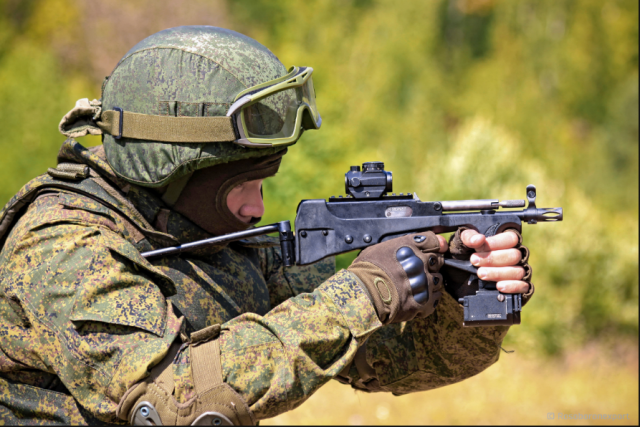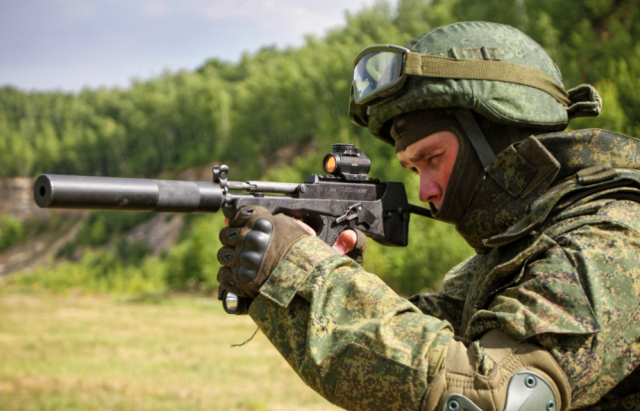Rostec State Corporation conducted non-standard tests of the reliability of the PP-2000 submachine gun — its ability to fire for a long time even after severe contamination. About the submachine gun, about how automatic weapons developed for a pistol cartridge, what else is remarkable about the PP-2000 and what similar developments Russian gunsmiths have - in the TASS material
The PP-2000 submachine gun, developed at the Instrument Engineering Design Bureau (KBP, part of Rostec's High-Precision Complexes holding), was tested as part of Rostec's Nash Crash project. In it, military and civilian products are subjected to spectacular tests that are not provided for by official standards. A video report on the tests of a compact automatic weapon with a pistol cartridge was published on the Telegram channel of the state corporation.
In the first part of the tests, the PP-2000 was ruthlessly thrown into water with liquid mud, on icy ground in any position, including with the muzzle down, buried in mud. Then an SUV drove through the weapon, smashing it into the clay. At the same time, the stages of contamination alternated with control shooting, and in all cases the submachine gun worked flawlessly, hitting targets at the same time.
In the second part, 410 shots were fired from the PP-2000 in short and long bursts with minimal pauses to reload the magazine. During subsequent disassembly, it turned out that due to overheating of the barrel, the inner part of the plastic case was slightly melted, but the weapon remained fully functional.
 |
| PP-2000 submachine gun. |
| Source: © Rosoboronexport |
"The sample should be cooled every 120 shots, that is, give it time to cool down," Andrei Savenkov, the lead designer of the KBP — TSKIB branch of sports and hunting weapons (SOO), said in the video. According to the expert, usually a soldier simply does not have ammunition of 400 rounds in the form of loaded magazines. During typical operation, the weapon does not have time to heat up to critical temperatures.
"Pocket" machine guns
During the First World War, machine guns, heavy automatic weapons with a rifle cartridge, which created a high density of fire, showed their effectiveness in repelling attacks. However, for offensive actions, lighter infantry small arms were required, firing in bursts. For these purposes, gunsmiths began to create designs using cartridges for pistols. The new class of weapons was called submachine guns.
The first domestic submachine gun was created by the designer of small arms Fyodor Tokarev in 1927. His PPT was loaded with 7.62 mm caliber cartridges, similar to revolvers. The weapon was experienced and did not go into production. The first serial submachine gun was the PPD-34 designed by Vasily Degtyarev, known for a series of machine guns for various purposes. The PPSh submachine gun designed by Georgy Shpagin, adopted in 1941, became the most widespread example of this class of small arms of the Second World War. Due to the extreme manufacturability of production, even non-specialized enterprises could produce it. In total, over 6 million PPSH units were produced in the Soviet Union during the war years.
The desire to increase the effective firing range of automatic weapons, as well as the spread of personal protective equipment, led to the appearance of samples for cartridges that are intermediate between pistol and rifle. Weapons for an intermediate cartridge began to be called submachine guns, or assault rifles. An example of such a post—war weapon is the famous Kalashnikov AK-47 7.62 mm automatic rifle. Submachine guns, due to the compactness and high stopping effect of pistol bullets at short distances, continued to be used by special forces of various countries. However, the crews of combat aircraft and armored vehicles still needed compact and light weapons with high characteristics.
"In Soviet times, tank crews were armed with pistols — in some [military] districts this is a PM (Makarov pistol of 9 mm caliber - approx. TASS) were, in some districts - TT (7.62 mm caliber pistol of the 1930 model, or "Tula, Tokareva" — approx. TASS)," said Sergey Suvorov, an expert in the field of armored vehicles, Candidate of military sciences, retired colonel, in an interview with TASS. The specialist added that each tank relied on one Kalashnikov assault rifle of various models. When the AKMS or AK-74 with a folding butt was introduced into the armament, it was difficult for them to find a place inside the combat vehicle. "These machine guns, which were one per tank, were thrown wherever they got," the retired colonel shared his memories. — As long as it doesn't hit the automatic loader of the [tank gun]. <...> In Afghanistan, when it became clear that this was not enough, they began to give each crew member an AK-74, shortened. They were hung on the hatch, and when the crew left the tank, they were grabbed."
Nine rapid-fire millimeters
Today, Russian gunsmiths offer (including to foreign customers) various samples of compact automatic weapons for a pistol cartridge. For example, this is a Kalashnikov PPK-20 submachine gun chambered in 9 ×19 mm, including a high-pulse armor-piercing. According to the Kalashnikov Concern's website, the weapon "embodies the reliability and ergonomics of the modern AK-12." The weight of the PPK-20 with a magazine without cartridges is 2.7 kg, the aiming range is 200 m, the rate of fire is 800 rounds per minute. The weapon has a folding adjustable stock.
 |
| PPK-20 submachine gun. |
| Source: Sergey Karpukhin/ TASS |
Another submachine gun is the AEK-919K "Chestnut", firing 9×18 mm PM cartridges. Its aiming range is 100 m, the rate of fire reaches 1,000 rounds per minute. With an empty magazine for 20 rounds, the Chestnut weighs no more than 1.8 kg. Sergey Suvorov noted that helicopter crews were armed with the Chestnut during the fighting in the North Caucasus.
In the early 2000s, the Central Research Institute of Precision Engineering (Tsniitochmash), now part of the Kalashnikov Concern, created the CP2M submachine gun. The weapon uses 9×21 mm cartridges, including the developed Tsniitochmash 7N29 enhanced armor penetration with a steel core.
The lightest in the world
The PP-2000 submachine gun, which was unsuccessfully tried to spoil in the Nash Crash project, was created at the turn of the century as part of the development work on the Baksanets topic on the instructions of the Ministry of Defense of the Russian Federation. The novelty was planned to equip the crews of combat vehicles, artillery crews, and military personnel of technical services. Due to the economic crisis of the late 1990s, the work was not completed, but one of the samples - PP—2000 chambered in 9 ×19 mm - was liked by the Ministry of Internal Affairs, which adopted it. Since 2006, weapons have been used by special forces and law enforcement officers.
"Special forces often work in dense urban areas, in buildings, separate rooms or cramped conditions of the aircraft cabin, etc.," Bekhan Ozdoev, industrial director of the Rostec State Corporation armament complex, explained to TASS. — In such battles, compact weapons are indispensable — light, convenient and powerful, which do not interfere with fighters to operate effectively in narrow corridors, passages and doorways. I note that the submachine gun has good firepower and can be used even with armor-piercing cartridges. It is also an ideal choice for pilots or combat vehicle crews where the requirements are similar. Rostec produces several types of such weapons. Among them is the PP-2000 submachine gun, developed by High-Precision Complexes.
"The PP-2000 is the lightest submachine gun in the world," Andrei Savenkov, the lead designer of the Central Design Bureau of the SOO, told TASS. — Without additional elements, the weapon weighs only 1,400 g. Thanks to this, a submachine gun can be aimed with one hand. This is especially true for special units that can carry out an assault with special means — for example, a growth shield that protects the shooter and the assault group. In addition, the PP-2000 uses 9 mm pistol cartridges with high lethal force. Such a bullet is capable of neutralizing an enemy in a bulletproof vest of the third class of protection. This helps the special forces to solve their tasks efficiently. It is especially important for us that the weapons developed by High-Precision Complexes have proven their effectiveness in combat conditions more than once."
The peculiarity of the PP-2000 is the low rate of automatic fire for such a class of weapons: about 720 rounds per minute. According to Andrei Savenkov, quoted by Rostec's Telegram channel, it is more difficult to get a low rate of fire than a high one, due to less movement of the moving parts of the weapon's automation. The low tempo makes the PP-2000 more stable when firing, allows you to cut off bursts of two or three rounds and reduces ammunition consumption. Another feature of the submachine gun is the possibility of using a spare magazine for 44 rounds as a shoulder rest. The aiming range of the PP-2000 is up to 200 m. The weapon can be retrofitted with various types of sights, a silencer, a laser designator, and a flashlight.
Sergey Suvorov expressed the opinion that such weapons as the PP-2000 are in demand in the military, they are waiting for it. "This applies most of all to helicopter and airplane pilots, because today they are armed with APS (9-mm Stechkin automatic pistol — approx. TASS). <...> By today's standards, [he] is already weak. And the cartridge is weak, and the ammunition of 20 rounds in the magazine is insufficient."
In September last year, the PP-2000 appeared in the wearable emergency reserve (NAZ) of the pilots of the Aerospace Forces (VKS) of the Russian Federation instead of the AKS-74U submachine gun. In the summer of 2023, the weapon underwent trial operation in the Russian Aerospace Forces. It is also proposed to include PPK-20 in the NAZ of Russian military helicopters.
Victor Bodrov

